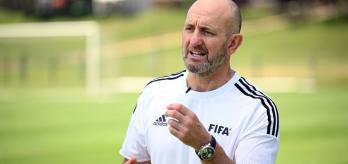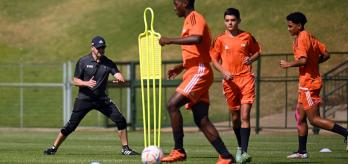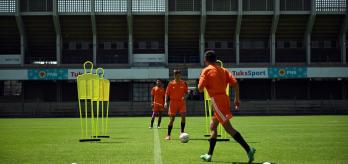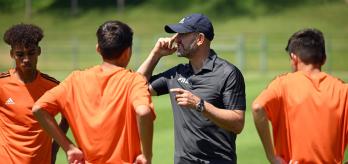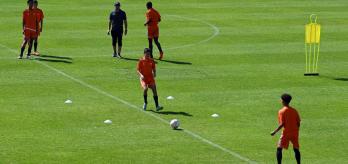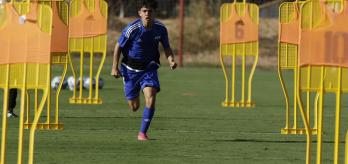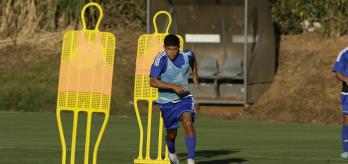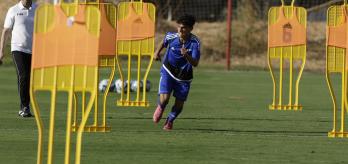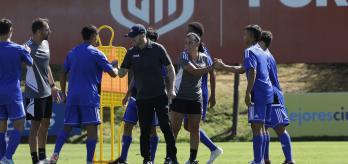Attaining near maximal speed and high volume, high-speed running (speed metrics) within game-related scenarios are the targeted training variables.
Emphasis and methodology
To achieve overall speed intensity objectives, the (technical physical) training methodology seen for previous phases is applied. However, this time it includes repeated bouts of high tempo technical interaction with high-quality connectivity between players. The emphasis is on offensive speed scenarios over 30-40m with a passing range of 15-30m.
For our drills, we use a 30 x 30m repeat out-and-back rotational sequence with very brief recovery times (1 to 2 seconds) between outbound and inbound rotation. To regulate overall speed intensity, the work-to-rest ratios start at approximately 1 to 4, with lower 1 to 3 ratios used when the primary target is in the high-speed-run zone for repeat capacity.
The methodology uses loaded speed exposure in a football functional environment. The tempo and intensity used in this session are appropriate for this phase of returning from injury. In addition, drills are technically balanced and good footballing awareness habits should be encouraged.
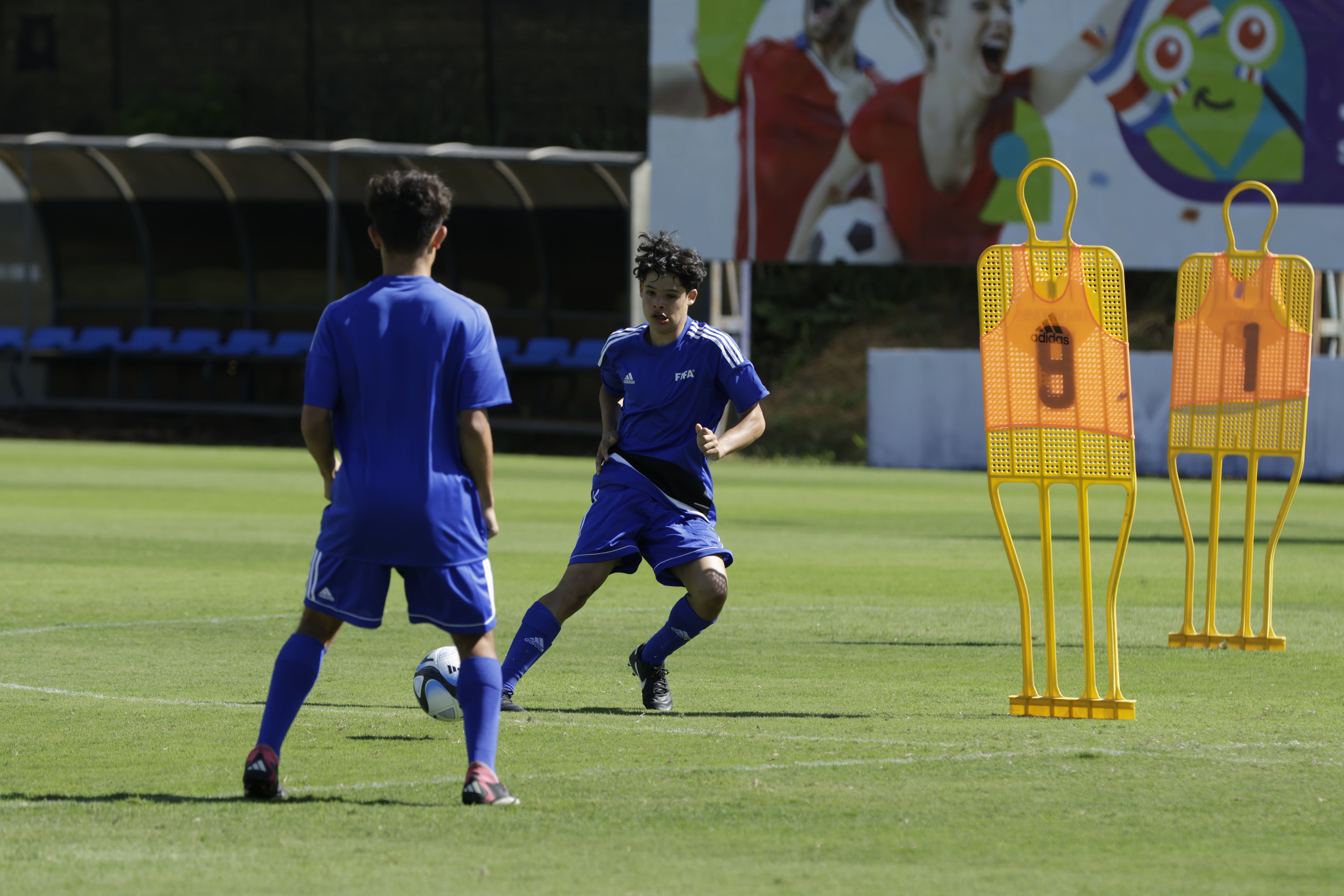
Overall objective and training perspective
Functional speed part I is appropriate as a one-off session during short-term injury lay off, i.e. 2 to 3 weeks, or a repeated workload session to help rebuild functional speed capacity for players sidelined for extended periods. The individual drills are designed for a minimum of 1 to 2 players assisted by two server players. However, if there is only one working player to prepare then three ball servers are required to fulfil the training requirements of the drills.
Implementation
Aimed at all on-the-field practitioners responsible for helping players return from injury, the drills in this session form part of an overall training programme to provide a variety of technical-physical training solutions (with a particular emphasis on the technical elements) for all phases of rehabilitation. Practitioners can select individual drills or entire sessions to fit their overall training plans for players in their care.
In addition, the drills within the session (functional speed and high-speed running) can be used for small training groups of 4 to 8 players, where the emphasis for the training is on speed metric volume with a technically biased approach.
Workload metrics
A simple table showing the duration of the drills, the number of sets, the work-to-rest ratios and guidelines for combining phase 1 and 3 drills can be found below.
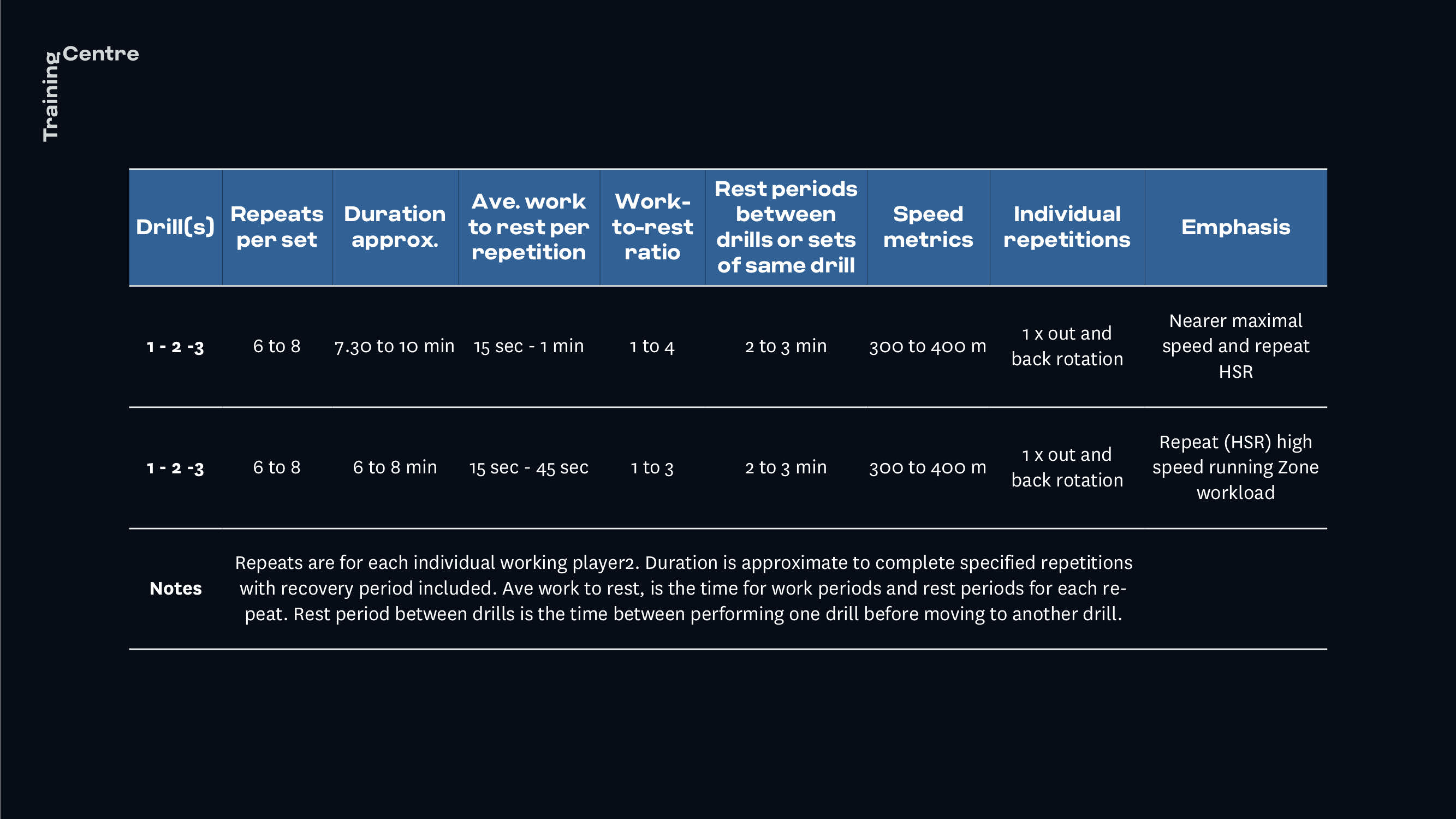

Set-up for all drills
Grid distances
-
Set up a 30 x 30m outer grid using flat discs or cones (a + b).
-
Set up a grid of 3 x double mannequin gates on the midpoint vertical line of the outer grid, placed 15m apart with 4-5m between the gates (c + d).
-
Place two flat disc/cones 10m beyond the mannequin gates at each end (e), 4-5m apart in line with the gates.
-
Place 2 mannequin gates 30m apart horizontally at the midline of the outer grid (f)
-
If poles or mannequins are not available, a mix of cones/discs may be used.
-
All drills require a minimum of 4 participants.
-
All drills are technically balanced, providing the opportunity to use both feet in equal measure.
-
The drills should start after a short period of familiarisation with the types of movement and relevant scenarios.
-
Encourage the players to change positions quickly during the technical interactions.
-
Periodically emphasise and encourage technical balance and reinforce awareness habits.
-
Ensure adequate recovery periods (as specified) between each repetition.
-
Encourage the players to maintain a good passing rhythm and tempo throughout the drills.
NB: For drills 1 and 2, there are two working players, with two server players or a combination of coach and server players supporting the working players for the out-and-back rotation. The focus for maximal speed is on working player 2. For drill 3, there is one working player, plus two server players and one supporting player.
If the main emphasis for a session is on more than one player, players continuously alternate after each out-and-back.
Drill 1: Long diagonal through pass played to meet a vertical run behind
-
Working player 2 starts the outbound rotation with a diagonal pass played back to the server player or coach.
-
The server player switches the ball out to the working player at the opposite side of the grid.
-
Working player 1 moves inside and looks to play a long diagonal through pass to working player 2.
-
Working player 2 times a strong in-behind high-speed-run in coordination with the pass and movement of the server and working player 1.
-
Upon latching on to the pass, working player 2 strokes the ball in towards the server at the opposite end of the grid.
NB: after playing the long through pass, working player 1 runs at high speed to the wide starting position at the opposite end of the grid. The sequence repeats for the inbound rotation.
-
For technical balance, working player 2 should be encouraged to use their left foot when playing the left-to-right pass to the server. The opposite applies when playing the right to left pass from the opposite end.
-
To reinforce good awareness habits, working player 1 should be encouraged to scan towards working player 2 and lift their head before playing the long through pass.
Drill 2: Long vertical through pass played to meet an infield diagonal run behind
-
The server player or coach starts drill 2 with a pass out wide to working player 1.
-
Working player 1 drops in to receive the ball and turns forward to play a vertical pass to meet the infield run in-behind from working player 2.
-
Working player 2 times their strong in-behind high-speed run from out wide to infield in coordination with the pass and movement of the server and working player 1.
-
Upon latching on to the pass, working player 2 strokes the ball in towards the server at the opposite end of the grid.
NB: After playing the pass to the server, working player 2 moves quickly out wide in preparation for the inbound rotation. After playing the vertical pass, working player 1 runs at high speed to the starting position at the opposite end of the grid in preparation for the inbound rotation. The sequence repeats for the inbound rotation.
-
For technical balance, working player 2 should be encouraged to use their left foot when playing the left to right pass to the server. The opposite applies when playing the right to left pass from the opposite end.
-
To reinforce good awareness habits, working player 1 should be encouraged to scan across to working player 2 and lift their head before playing the vertical pass.
Drill 3: Give inside and go behind for the return pass
-
The server player or coach starts drill 3 with a pass out wide to the working player.
-
The working player drops in to receive the ball, then turns forward and plays an infield give-and-go with the central support player.
-
The working player makes a strong high-speed run into the space beyond the support player.
-
The support player slots a return pass into the high-speed run of the working player.
-
Upon latching on to the pass, the working player strokes the ball in towards the server at the opposite end of the grid.
-
The sequence repeats for the inbound rotation.
-
For technical balance, the working player should be encouraged to use their left foot when playing the left-to-right passes to both the support player and servers. The opposite applies when playing the right to left pass from the opposite end.
-
To reinforce good awareness habits, the working player should be encouraged to scan towards the support player to get their head up before playing the pass.









